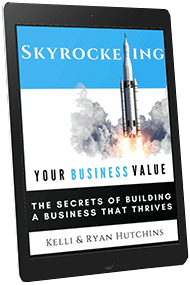
Reducing Owner Dependence
If you left today on vacation for 3 months, would your business survive and run smoothly without you? If not, your business may have high owner dependence. The more your team and clients need you, the less valuable your company will be to a potential buyer.
Structuring your business so it can independently run without you not only makes your company more valuable but also more sellable. Shifting to this structure allows the business owner to take a step away from the business. Without the owner at the center of it all, the company becomes more valuable.
Potential buyers want a business with processes that run smoothly with or without you. High owner dependence makes it difficult to improve and evolve the business with a new owner and increases risk. In addition, employees often don’t get the opportunity to grow and become advocates for your brand.
Peak Business Valuation is happy to answer any questions you may have. Reach out by scheduling a free consultation. We look forward to hearing from you!
Risk of Owner Dependence
High owner dependence presents a major risk for a potential acquirer. The more dependent a business is on the owner or a key employee the higher the personal goodwill. Companies with high personal goodwill typically have a lower value. This is because there is an increased risk that business operations will decline with the transition of ownership. Potential buyers seek to answer the following questions to assess their risk.
- Will the business continue to grow without the influence of its owner?
- Is the company dependent on the owner for its success?
- Are key relationships tied to the owner or a key employee?
- What key employees will be staying with the business through the transaction?
These questions will greatly impact the value of the business in the eyes of a potential buyer.
Strategies to Reduce Owner Dependence
To maximize the value of your business, set a goal to quietly slip into the background, and let your team take center stage. Here are seven strategies to structure your business so it can run independently and be more easily transferable.
1. Build a strong management team
The first place to start is building a strong management team. Giving the authority to delegate and make decisions to a management team allows them to grow and step up to the plate. Keep in mind training the right individuals to run the business can take quite some time. Choose individuals who are passionate about the industry and understand the vision of the company.
Start by hiring a second in command. A second in command can help you execute your exit strategy and meet the demands of running the company.
Most potential buyers can find individuals to manage the books and keep trains running on time. However, they do not want to lose key relationships or revenue. As such, make sure there is someone in the company who is staying to continue these key relationships. By choosing the right people on your management team, hopefully, your business will run smoothly whether you are there or not.
2. Increase confidence and capability of the team
Once you have a great management team in place, don’t be afraid to shout it from the rooftops. Potential buyers will want to know the business will continue to grow without you. One of the best ways to show this is by talking up your team.
Endorsing their knowledge and expertise will not only increase the confidence of your team but also increase the confidence of a potential buyer. When creating organizational charts or bios consider reordering the list so that it is alphabetical rather than hierarchical. Additionally, make sure your bio is not the longest. Lastly, giving attention to key players will go a long way for confidence, credibility, and capability.
3. Delegate decision-making and problem-solving
While hiring the right people is the first step, it is vital to empower them to make decisions and solve problems. Rather than spending your valuable time answering customers’ questions, begin directing them to the right person on your team to answer. This gives employees the opportunity to work with clients one-on-one and build their own knowledge and problem-solving skills. Make sure your team knows that you have confidence in giving them more responsibility.
Remaining in the nitty-gritty details, constantly solving problems, and making day-to-day decisions reduce your ability to take a step back. It can also hinder the company’s growth and cause a buyer to question whether the business will continue to grow once it is transferred.
4. Document key information
Processes should not just be in your head. Build out a system for every process so your team and the potential acquirer will know how to keep things running. Prospective buyers want to see that processes are well-documented and that they can catch up to speed quickly. This makes the transfer much easier post-closing.
Outline not only how things work, but why they work. Proper documentation helps your management team have key information available when making decisions. Executing this step now means you can take a stress-free vacation for a few weeks knowing everything will continue to run smoothly. It may seem like a tedious task, but it is crucial to reducing owner dependence. Ultimately, it will pay off in the long run.
5. Build a sellable brand
Branding is key to the salability of your business. For instance, if your surname is in your company name, consider rebranding. Having your name part of the business name automatically incentives a customer to speak with the owner rather than someone else from the team. Be sure your business isn’t just known for who you are as a person, but rather for the product or service you provide.
6. Spend less time in the office
Start by reducing your working time. For many business owners, their life is their work. This includes days, nights, weekends, and vacations. Begin by choosing a select time you do not work. This includes not replying to employee calls and client questions unless of course there is an emergency. The best employees will get the picture and start taking ownership and begin making decisions independently.
7. Plan your exit
As a small business owner, it is important to have an exit plan for your company. This will allow you to transition your business smoothly when the time comes whether it is tomorrow, next year, or in ten years. Planning now will help ensure your business stays on track and achieves your goals. This plan will include goals that will ultimately increase the value of your company before a sale. Include your management team as they are key in successfully executing your exit strategy.
Peak Business Valuation, a business appraiser in Utah, can help you understand the value of your company today so you can create a comprehensive exit strategy. Your exit strategy should be tailored to your specific needs and goals. Planning now will help you find the right buyer and ensure a successful transition. It will also help you reduce owner dependence and maximize the value when it is time to sell.
Summary
By using the above strategies and building an effective team, you can increase your company’s valuation and create a more sellable business. Making structural changes in your business can be complicated and counterintuitive. Changes in the short term may even have a negative impact. However, once your team is fully and independently functioning, your business can scale even more and maximize the value.
Whether you are planning to sell now, or 5 to 10 years down the road, now is the time to ensure your business is not all about you. Peak Business Valuation is here to help business owners grow their company. Start by scheduling your free consultation.
Schedule Your Free Consultation Today!
